小学英语《Unit 3 Where did you go》优质教案、教学设计
- 格式:docx
- 大小:547.54 KB
- 文档页数:5
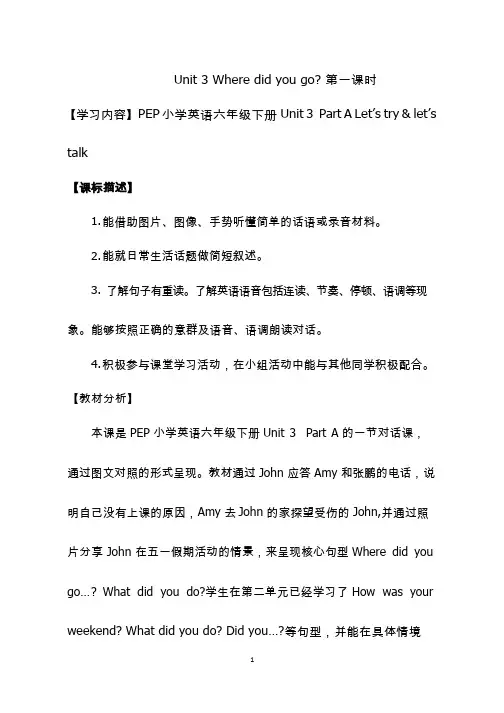
Unit 3 Where did you go? 第一课时【学习内容】PEP 小学英语六年级下册Unit 3 Part A Let’s try & let’s talk【课标描述】1.能借助图片、图像、手势听懂简单的话语或录音材料。
2.能就日常生活话题做简短叙述。
3.了解句子有重读。
了解英语语音包括连读、节奏、停顿、语调等现象。
能够按照正确的意群及语音、语调朗读对话。
4.积极参与课堂学习活动,在小组活动中能与其他同学积极配合。
【教材分析】本课是PEP 小学英语六年级下册Unit 3 Part A 的一节对话课,通过图文对照的形式呈现。
教材通过John 应答Amy 和张鹏的电话,说明自己没有上课的原因,Amy 去John 的家探望受伤的John,并通过照片分享John 在五一假期活动的情景,来呈现核心句型Where did you go…? What did you do?学生在第二单元已经学习了How was your weekend? What did you do? Did you…?等句型,并能在具体情境中进行较好的运用。
【学习目标】1.通过读图猜测,视频问答,听音模仿和flash 动画等活动,理解对话大意,了解新疆的风土人情,并能在语境中理解生词及词组:fell off, Labour Day, mule, Turpan, could 及till 的意思,并能正确发音。
2.通过听音模仿,角色扮演,借助板书设计和小组合作谈论holiday,能够听说读写核心句型:What happened? Are you all right?I’m OK now. Where did you go? It looks like a mule! Did you go to Turpan? Yes, we did.用正确的语音语调朗读对话,并能恰当运用核心句型谈论假期活动。
3.通过听前猜测和听后猜测,借助多媒体,能运用基本的听力技巧完成Let’s try,的听力任务。
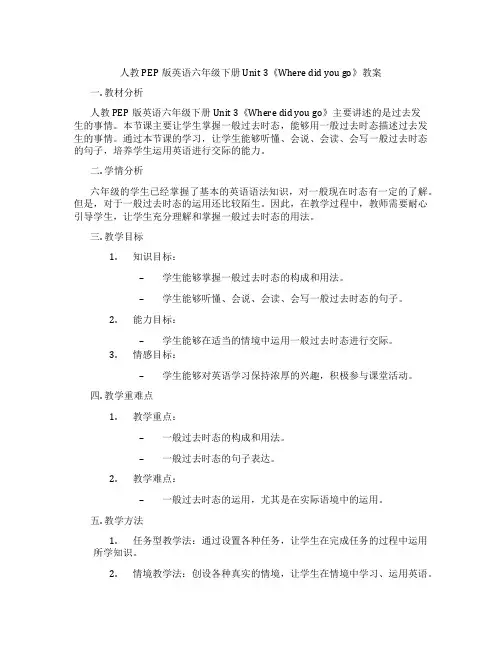
人教PEP版英语六年级下册Unit 3《Where did you go》教案一. 教材分析人教PEP版英语六年级下册Unit 3《Where did you go》主要讲述的是过去发生的事情。
本节课主要让学生掌握一般过去时态,能够用一般过去时态描述过去发生的事情。
通过本节课的学习,让学生能够听懂、会说、会读、会写一般过去时态的句子,培养学生运用英语进行交际的能力。
二. 学情分析六年级的学生已经掌握了基本的英语语法知识,对一般现在时态有一定的了解。
但是,对于一般过去时态的运用还比较陌生。
因此,在教学过程中,教师需要耐心引导学生,让学生充分理解和掌握一般过去时态的用法。
三. 教学目标1.知识目标:–学生能够掌握一般过去时态的构成和用法。
–学生能够听懂、会说、会读、会写一般过去时态的句子。
2.能力目标:–学生能够在适当的情境中运用一般过去时态进行交际。
3.情感目标:–学生能够对英语学习保持浓厚的兴趣,积极参与课堂活动。
四. 教学重难点1.教学重点:–一般过去时态的构成和用法。
–一般过去时态的句子表达。
2.教学难点:–一般过去时态的运用,尤其是在实际语境中的运用。
五. 教学方法1.任务型教学法:通过设置各种任务,让学生在完成任务的过程中运用所学知识。
2.情境教学法:创设各种真实的情境,让学生在情境中学习、运用英语。
3.交际法:鼓励学生积极参与课堂交际活动,提高学生的英语交际能力。
六. 教学准备1.教师准备:–教材、教案、课件。
–与本节课相关的故事书、图片、视频等教学资源。
2.学生准备:–预习本节课的内容。
–准备一本英语故事书,用于课堂上的阅读和分享。
七. 教学过程1.导入(5分钟)–教师与学生用英语进行自由对话,复习一下之前学过的一般现在时态。
–引导学生谈论一下他们平时喜欢做的事情,激发学生的兴趣。
2.呈现(10分钟)–教师展示一张图片,图片上有一个学生在画画。
–教师问学生:“Where did he go?”,学生回答:“He went to draw pictures.”–教师引导学生注意到句子中的“went”和“drew”,解释一般过去时态的构成和用法。
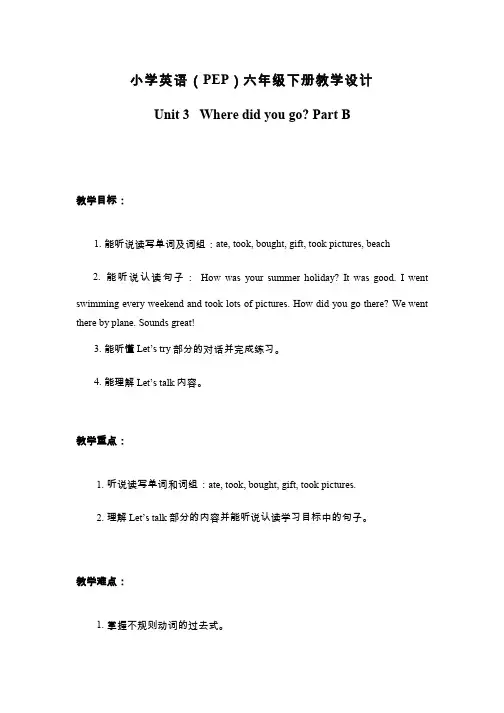
小学英语(P EP)六年级下册教学设计Unit 3 Where did you go? Part B教学目标:1.能听说读写单词及词组:ate, took, bought, gift, took pictures, beach2.能听说认读句子:How was your summer holiday? It was good. I went swimming every weekend and took lots of pictures. How did you go there? We went there by plane. Sounds great!3.能听懂Let’s try 部分的对话并完成练习。
4.能理解Let’s talk 内容。
教学重点:1.听说读写单词和词组:ate, took, bought, gift, took pictures.2.理解Let’s talk 部分的内容并能听说认读学习目标中的句子。
教学难点:1.掌握不规则动词的过去式。
2.用所学句型简单介绍自己的summer holiday and winter holiday.教学过程:一、Greetings and Warm-up1.师生相互问好、鼓励。
2.出示yesterday and last 单词卡。
引出过去式概念。
3 、free talkWhat happened?What did you do yesterday/last Sunday/last weekend.?练习过去式回答问题。
4. Show 单词卡holiday,引出今天学习任务发生的时间以及学习目标。
Summer holiday and winter holiday.二、Presentation1.教学短语(1)T: eat fresh food eat-ate同样的方法教学take pictures, buy gifts, go swimming(2)呈现句子What did Wu Yifan do? He ate fresh food.同样的方法教学He went swimming. He took pictures,. He bought gifts.(3)T: What did Wu Yifan do in the summer holiday?Ss: He ate fresh food.(学生多操练)2.T: How was your summer holiday?Ss: It was good. I went fishing every weekend and took lots of pictures.师生互答。

Unit 3 Where did you go? 第一课时【学习内容】PEP 小学英语六年级下册Unit 3 Part A Let’s try & let’s talk【课标描述】1.能借助图片、图像、手势听懂简单的话语或录音材料。
2.能就日常生活话题做简短叙述。
3.了解句子有重读。
了解英语语音包括连读、节奏、停顿、语调等现象。
能够按照正确的意群及语音、语调朗读对话。
4.积极参与课堂学习活动,在小组活动中能与其他同学积极配合。
【教材分析】本课是PEP 小学英语六年级下册Unit 3 Part A 的一节对话课,通过图文对照的形式呈现。
教材通过John 应答Amy 和张鹏的电话,说明自己没有上课的原因,Amy 去John 的家探望受伤的John,并通过照片分享John 在五一假期活动的情景,来呈现核心句型Where did you go…? What did you do?学生在第二单元已经学习了How was your weekend? What did you do? Did you…?等句型,并能在具体情境中进行较好的运用。
【学习目标】1.通过读图猜测,视频问答,听音模仿和flash 动画等活动,理解对话大意,了解新疆的风土人情,并能在语境中理解生词及词组:fell off, Labour Day, mule, Turpan, could 及till 的意思,并能正确发音。
2.通过听音模仿,角色扮演,借助板书设计和小组合作谈论holiday,能够听说读写核心句型:What happened? Are you all right?I’m OK now. Where did you go? It looks like a mule! Did you go to Turpan? Yes, we did.用正确的语音语调朗读对话,并能恰当运用核心句型谈论假期活动。
3.通过听前猜测和听后猜测,借助多媒体,能运用基本的听力技巧完成Let’s try,的听力任务。

小学英语《Unit3Wheredidyougo》优质课教学设计、教案Unit 3 Where did you go ?Part B Let’s talk一、教学目标学生能够在老师的帮助下,借助图片,理解对话大一,并能回答对话下面的问题。
能够在语境中理解生词beach 的意思,并能正确发音。
能通过对话了解海南三亚的海岛风光。
能够用正确的语音、语调朗读对话,并进行角色表演。
能听说读写,并能在情境中恰当运用以下句型Where did you go...?How didi you go there ?What did you do ?谈论假期活动;能够在情境中恰当运用由Where, What,和hoe 引导的一般过去时特殊疑问句。
二、教学重、难点能在语境中恰当运用由where,what 和how 引导的一般过去时特殊疑问句。
三、教学过程一、热身(Warm-up)1. 师生齐唱歌曲“T ell me about your holiday ?”2.Let’s play a game!(热身/复习的设计意图:歌曲、游戏热身,激发学生的学习兴趣,复习所学短语和句子,为学习新知做铺垫.并能从旧知识自然过度到新内容上来.)二、呈现新课(Presentation)1.班上来了一位新同学,教师介绍后,学生进行自我介绍。
I’m Peter.I like reading books and playing basketball. I like travelling very much .Today , I bring you a special gift. Look , It’s a Travel star trophy. Please tell me about your trip. If you arethe winner. I’ll give it to you .2.师生对话导入课文,引出课文内容:Where did you go over your winter holiday ?My family and I went to Sanya.Really. Did youlike it ?Yes. It was so warm.3.教师带领学生观看美丽三亚的图片,让学生通过观察,体验三亚的美丽景色,并且会进行描述。
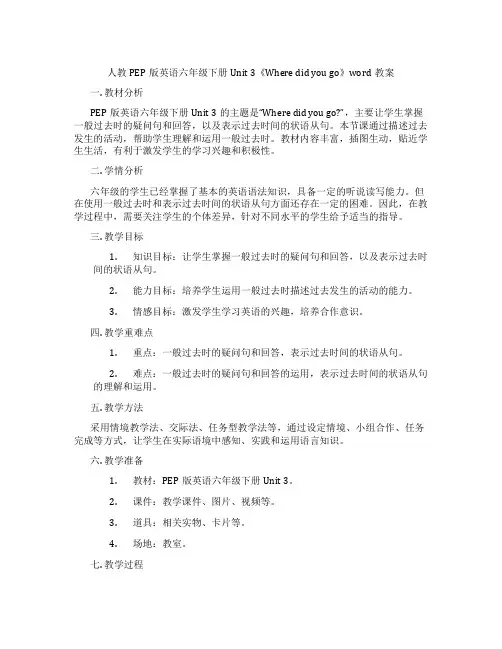
人教PEP版英语六年级下册Unit 3《Where did you go》word教案一. 教材分析PEP版英语六年级下册Unit 3的主题是“Where did you go?”,主要让学生掌握一般过去时的疑问句和回答,以及表示过去时间的状语从句。
本节课通过描述过去发生的活动,帮助学生理解和运用一般过去时。
教材内容丰富,插图生动,贴近学生生活,有利于激发学生的学习兴趣和积极性。
二. 学情分析六年级的学生已经掌握了基本的英语语法知识,具备一定的听说读写能力。
但在使用一般过去时和表示过去时间的状语从句方面还存在一定的困难。
因此,在教学过程中,需要关注学生的个体差异,针对不同水平的学生给予适当的指导。
三. 教学目标1.知识目标:让学生掌握一般过去时的疑问句和回答,以及表示过去时间的状语从句。
2.能力目标:培养学生运用一般过去时描述过去发生的活动的能力。
3.情感目标:激发学生学习英语的兴趣,培养合作意识。
四. 教学重难点1.重点:一般过去时的疑问句和回答,表示过去时间的状语从句。
2.难点:一般过去时的疑问句和回答的运用,表示过去时间的状语从句的理解和运用。
五. 教学方法采用情境教学法、交际法、任务型教学法等,通过设定情境、小组合作、任务完成等方式,让学生在实际语境中感知、实践和运用语言知识。
六. 教学准备1.教材:PEP版英语六年级下册Unit 3。
2.课件:教学课件、图片、视频等。
3.道具:相关实物、卡片等。
4.场地:教室。
七. 教学过程1.导入(5分钟)利用图片和视频展示,引导学生回顾Unit 2学过的内容,为新课的学习做好铺垫。
2.呈现(5分钟)通过课件展示Unit 3的内容,引导学生关注一般过去时的疑问句和回答,以及表示过去时间的状语从句。
3.操练(10分钟)分组进行角色扮演,让学生运用一般过去时和表示过去时间的状语从句进行对话。
教师巡回指导,纠正发音和语法错误。
4.巩固(10分钟)设计一些练习题,让学生书面完成,检测对一般过去时和表示过去时间的状语从句的掌握情况。
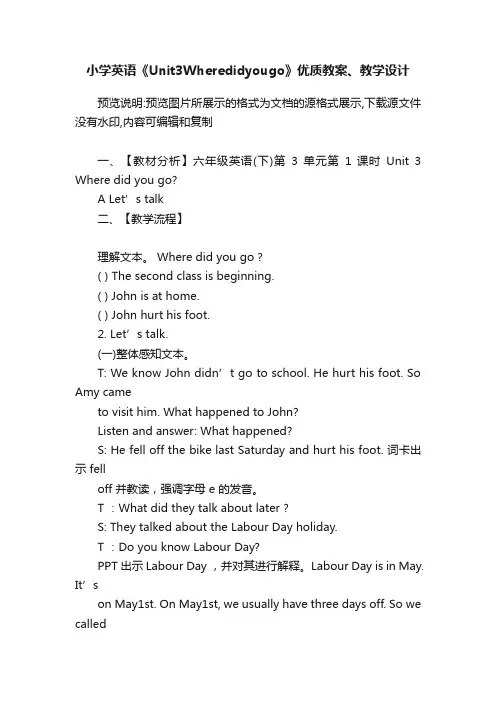
小学英语《Unit3Wheredidyougo》优质教案、教学设计预览说明:预览图片所展示的格式为文档的源格式展示,下载源文件没有水印,内容可编辑和复制一、【教材分析】六年级英语(下)第3 单元第1 课时Unit 3 Where did you go?A Let’s talk二、【教学流程】理解文本。
Where did you go ?( ) The second class is beginning.( ) John is at home.( ) John hurt his foot.2. Let’s talk.(一)整体感知文本。
T: We know John didn’t go to school. He hurt his foot. So Amy cameto visit him. What happened to John?Listen and answer: What happened?S: He fell off the bike last Saturday and hurt his foot. 词卡出示 felloff 并教读,强调字母 e 的发音。
T :What did they talk about later ?S: They talked about the Labour Day holiday.T :Do you know Labour Day?PPT 出示 Labour Day ,并对其进行解释。
Labour Day is in May. It’son May1st. On May1st, we usually have three days off. So we calledit Labour Day. 词卡出示,并教读。
T: Do you love Labour Day? John loves Labour Day too.(二)再次 Listen again and answer :1)Where did John go on Labour Day holiday?2) What did John do there?学习句子:Where did you g o ? I went to….S: He went to Mt.Tianshan and Turpan in Xinjiang.T: Do you know Xinjiang? 出示新疆地图,并做解释。

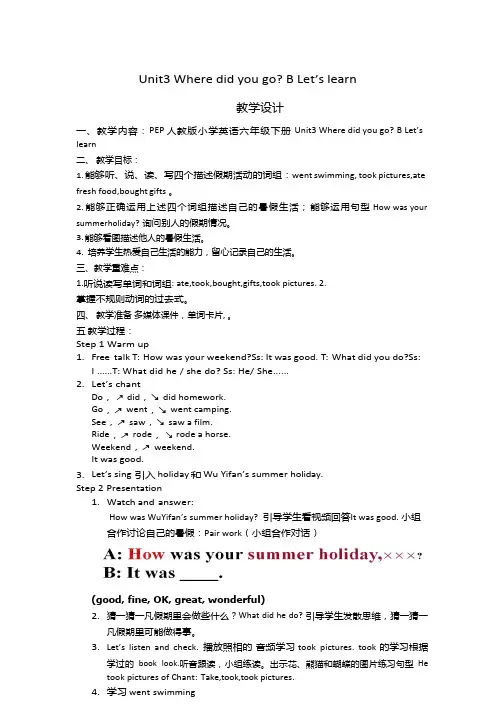
Unit3 Where did you go? B Let’s learn教学设计一、教学内容:P EP 人教版小学英语六年级下册Unit3 Where did you go? B Let’s learn二、教学目标:1.能够听、说、读、写四个描述假期活动的词组:went swimming, took pictures,ate fresh food,bought gifts 。
2.能够正确运用上述四个词组描述自己的暑假生活;能够运用句型How was your summerholiday? 询问别人的假期情况。
3.能够看图描述他人的暑假生活。
4.培养学生热爱自己生活的能力,留心记录自己的生活。
三、教学重难点:1.听说读写单词和词组: ate,took,bought,gifts,took pictures.2.掌握不规则动词的过去式。
四、教学准备多媒体课件,单词卡片, 。
五教学过程:Step 1 Warm up1.Free talk T: How was your weekend?Ss: It was good. T: What did you do?Ss:I ......T: What did he / she do? Ss: He/ She......2.Let’s chantDo,↗did,↘did homework.Go,↗went,↘went camping.See,↗saw,↘saw a film.Ride,↗rode,↘rode a horse.Weekend,↗weekend.It was good.3.Let’s sing 引入holiday 和Wu Yifan’s summer holiday.Step 2 Presentation1.Watch and answer:How was WuYifan’s summer holiday? 引导学生看视频回答It was good. 小组合作讨论自己的暑假:Pair work(小组合作对话)(good, fine, OK, great, wonderful)2.猜一猜一凡假期里会做些什么?What did he do? 引导学生发散思维,猜一猜一凡假期里可能做得事。

Unit 3 Where did you go?Part A 第一课时 (1)Part A 第二课时 (4)Part A 第一课时Let’s try & Let’s talk教学目标1.能听、说、认读fell,off,mule,could,till,Labour Day,Turpan等词汇。
2.能听懂Let’s try的内容,并完成对应的训练题。
3.能理解Let’s talk的内容,并能熟练朗读对话。
教学重点1.听、说、认读句子:What happened?Are you all right?I’m OK now.Where did you go?Did you go to Turpan?Yes,we did.2.理解重点句型,并能运用过去式谈论假期活动。
教学难点运用句型“Where did you go?What did you do?”询问并回答有关假期去过的地方及做过的事情。
教学准备1.单词卡片2.录音机及录音带或教学光盘3.多媒体课件教学过程Step 1:Warm-up1.师生相互问候。
2.播放英语歌“Tell me about your holiday”,让学生跟着录音学唱。
3.“打擂台”游戏。
规则:请五名学生到教室前面,教师任意抽取一张短语卡片,让五名学生根据卡片上的内容造句,如:I watched TV last weekend.不能正确造句的学生即被淘汰出局。
然后教师出示另一张卡片,留在台上的学生继续比赛。
最后留在台上的学生成为擂主。
Step 2:Presentation1.Let’s try.(1)教师通过问候对话谈论的关于假期的话题,引导学生猜猜看John的假期过得怎么样。
(2)教师播放录音,学生完成题目。
(3)教师追问学生:Why was John at home?引导学生进行猜测。
教师再次放录音,学生根据录音回答问题。
2.Let’s talk.(1)教师播放本部分动画,学生带着问题观看动画,看后回答问题:①What happened to John last Saturday?②What did they talk about later?(2)教师利用图片帮助学生理解短语fell off;教师结合日历,让学生理解Labour Day holiday的概念。
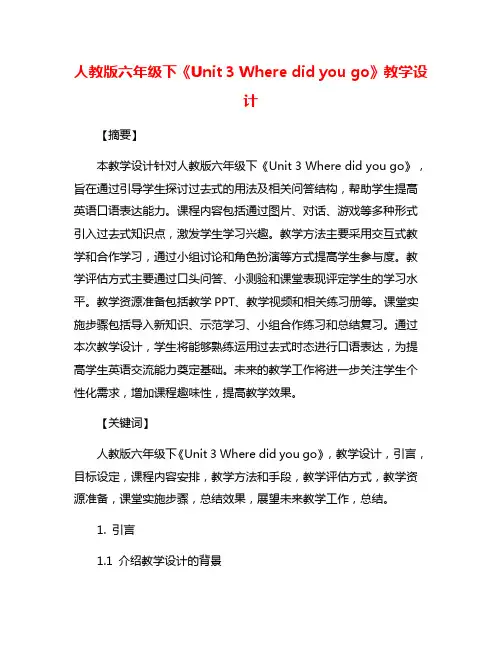
人教版六年级下《Unit 3 Where did you go》教学设计【摘要】本教学设计针对人教版六年级下《Unit 3 Where did you go》,旨在通过引导学生探讨过去式的用法及相关问答结构,帮助学生提高英语口语表达能力。
课程内容包括通过图片、对话、游戏等多种形式引入过去式知识点,激发学生学习兴趣。
教学方法主要采用交互式教学和合作学习,通过小组讨论和角色扮演等方式提高学生参与度。
教学评估方式主要通过口头问答、小测验和课堂表现评定学生的学习水平。
教学资源准备包括教学PPT、教学视频和相关练习册等。
课堂实施步骤包括导入新知识、示范学习、小组合作练习和总结复习。
通过本次教学设计,学生将能够熟练运用过去式时态进行口语表达,为提高学生英语交流能力奠定基础。
未来的教学工作将进一步关注学生个性化需求,增加课程趣味性,提高教学效果。
【关键词】人教版六年级下《Unit 3 Where did you go》,教学设计,引言,目标设定,课程内容安排,教学方法和手段,教学评估方式,教学资源准备,课堂实施步骤,总结效果,展望未来教学工作,总结。
1. 引言1.1 介绍教学设计的背景本次教学设计的背景是人教版六年级下《Unit 3 Where did you go》,该单元主要围绕着谈论过去发生的事情展开。
学生需要学习如何描述自己和他人曾经去过的地方,并能够使用一般过去时态来表达过去发生的动作。
这个单元的教学内容对于学生来说具有一定的挑战性,需要他们掌握新的语法知识和词汇,并能够运用到实际的交流中。
在教学设计中我将注重激发学生的学习兴趣,通过生动而有趣的教学方法来引导他们学习,提高他们运用语言的能力。
通过本单元的学习,学生将能够更加熟练地运用一般过去时态,提高他们的口语表达能力和交流能力。
希望通过这个教学设计,能够激发学生学习英语的兴趣,提高他们的学习效果,并为他们打下坚实的语言基础。
1.2 目标设定目标设定部分要求学生通过本单元的学习,能够掌握以下几个方面的能力:1. 理解并掌握本单元所涉及的地点词汇及相关句型结构,能够正确运用于实际情境中进行交流。
Unit 3 Where did you go?第四课时教学设计〔Part B. Let's talk and let’s try〕教学目标:〔1〕知识与技能目标:能够运用句型“Where did you go over your winter holiday? I……〞 What did you do there?询问别人在假期里所做的事情并做答。
能够理解 How did you do there ? we went there by plane. 〔3〕情感态度与价值观:给学生进行平安教育,让学生知道外出旅行要注意平安。
教学重点:掌握句型:“Where did you go over your holiday? I went to ...〞What did you do?并能在情景中应用。
教学难点:能运用所学的句型与别人讨论假期旅游的情景。
教具准备:1、本课时的动词短语卡片。
2、本课时的单词卡片。
小组合作法Teaching Procedure :Step I: Review lessons.1.Play the game “act and speak〞to review the phrases.2.Review the last lesson in groups.Step II: Presentation1.Lead-inPlay the game “listen and guess〞 to learn the new words and phrases.2.The teacher shows a picture and introduce the holiday.I went to Singapore last year. I went there by plane.I took many pictures and ate delicious food. And the beach is very beautiful.3.Our friend Amy also had a trip last winter holiday. Where did she go? What did she do there? Let’s go to see together.4.The students study the conversation in groups with some Tasks.Task 1:Try to translate the conversation.Task 2:Find out the key sentences and phrases.Task 3:Ask some questions.【设计意图】设计任务型活动,有利于学生学习英语知识,开展语言技能,从而提高运用英语你能力。
人教PEP版英语六年级下册Unit 3《Where did you go》(Look and say)教案一. 教材分析人教PEP版英语六年级下册Unit 3《Where did you go》主要讲述的是关于过去发生的事情。
本节课主要通过Look and say的方式让学生复习和巩固一般过去时态,并学会用一般过去时态描述过去发生的事情。
教材内容丰富,插图生动有趣,激发学生的学习兴趣。
二. 学情分析六年级的学生已经学习过一般过去时态,对本节课的内容有一定的了解。
但在实际运用中,部分学生可能对时态的运用还不够熟练。
因此,在教学过程中,需要针对学生的实际情况进行有针对性的教学。
三. 教学目标1.能听懂、会说、会读本节课的主要单词和句型。
2.能用一般过去时态描述过去发生的事情。
3.培养学生的团队合作意识和口头表达能力。
四. 教学重难点1.重点:一般过去时态的运用。
2.难点:一般过去时态在实际情景中的运用。
五. 教学方法1.任务型教学法:通过完成各种任务,让学生在实践中学会运用英语。
2.情境教学法:创设各种情境,让学生在真实的环境中学习英语。
3.小组合作学习:培养学生团队合作精神和口头表达能力。
六. 教学准备1.教学课件:制作与本节课内容相关的课件,以便于教学展示。
2.图片:准备与本节课相关的人物、地点和活动的图片。
3.任务单:为学生准备任务单,以便于学生在课堂上完成任务。
七. 教学过程1.导入(5分钟)利用图片引导学生复习一般过去时态,引导学生说出过去发生的事情。
如:I went to the zoo yesterday.2.呈现(10分钟)呈现本节课的主要单词和句型,让学生听懂、会说。
如:Where did you go? I went to…3.操练(10分钟)分组进行角色扮演,让学生模拟对话,练习一般过去时态的运用。
如:A: Where did you go last weekend? B: I went to the park.4.巩固(10分钟)让学生完成任务单,运用所学知识描述过去发生的事情。
人教PEP版英语六年级下册Unit 3《Where did you go》(Lets sing)教学设计一. 教材分析人教PEP版英语六年级下册Unit 3主要围绕“旅行”这一主题展开,通过描述不同人物的旅行经历,让学生学会询问和描述别人的旅行经历。
Lets sing部分是一首名为“Where did you go”的歌曲,歌曲中描述了不同人物去不同地方旅行的情景,歌词内容与单元主题紧密相连,有助于学生巩固本单元所学知识。
二. 学情分析六年级的学生已经掌握了基本的英语语法和词汇,具备一定的听说读写能力。
他们在学习过程中善于模仿和重复,对于有趣的歌曲和活动充满热情。
然而,部分学生可能在唱歌方面缺乏自信,需要鼓励和支持。
此外,学生对于描述旅行经历的语言表达还比较陌生,需要在教学中进行引导和练习。
三. 教学目标1.知识目标:学生能够听懂、唱准歌曲“Where did you go”,并理解歌曲中所描述的旅行经历。
2.能力目标:学生能够用英语询问和描述别人的旅行经历,提高口语表达能力。
3.情感目标:通过歌曲和活动,激发学生对旅行的兴趣,培养他们积极的生活态度。
四. 教学重难点1.重点:学生能够听懂、唱准歌曲“Where did you go”,并运用其中的词汇和句型描述旅行经历。
2.难点:学生能够正确发音单词“Where did you go, I went to the zoo, Isaw some monkeys”,并在实际情景中运用。
五. 教学方法1.情境教学法:通过设置旅行相关的情境,让学生在实际语境中学习和运用英语。
2.全身反应法:通过歌曲和动作,激发学生的学习兴趣,提高他们的参与度。
3.任务型教学法:通过小组合作和角色扮演等活动,培养学生的团队合作意识和口语表达能力。
六. 教学准备1.教师准备:熟悉歌曲“Where did you go”的歌词和旋律,准备相关的教学材料和道具。
2.学生准备:提前让学生熟悉歌曲“Where did you go”,了解歌词内容。
Unit 3Where did you go? 教学设计一、话题:Amy’s winter holiday二、语用任务目标:在Sarah和Amy通话交流寒假假期的语境中,学生能使用动画、图片的方式尝试使用核心语言完成描述、询问、分享自己的假期,学生能够运用本单元学习的单词和句子描述过去发生的事情。
三、语言学习目标:1)学生能听懂、认读核心词汇:took pictures, went swimming, ate fresh food, bought gifts2)学生能听懂、认读核心句型:Where did you go?How did you go there?What did you do?3)绝大多数学生能够运用核心语言询问、应答、交流自己的假期。
四、体验目标:(1)文化情感学生能够了解海南三亚的海岛风光。
(2)学习策略在语境中,学生能通过互问互答、情景表演等方式,积极运用所学内容进行自信表达和交流。
听前预测,培养了逻辑思维能力。
引导学生读图,培养学生读图探究能力。
五、教学重难点:重点:1)能听、说、读、写核心词汇:ate fresh food, went swimming, took pictures, bought gifts 2)掌握四会句子:Where did you go?How did you go there? What did you do?难点:能根据实际情况运用句型“Where did you go? How did you go there? What did you do?”询问并描述过去发生的事。
六、教学设计Step one: Warm-up1)Sing a song2)Free talk :T: How was your winter holiday?S: It was ....T: What did you do last winter holiday?S: I ...T: Where did you go?S:I went to…【设计意图】歌曲导入,激发学生兴趣。
人教PEP版英语六年级下册Unit 3《Where did you go》(歌曲)教学设计一. 教材分析《Where did you go》是人教PEP版英语六年级下册Unit 3的内容,这首歌谣以轻松愉快的旋律和简单易懂的歌词,让学生在唱歌的过程中学习一般过去时态和描述过去发生的事情。
通过这首歌谣,学生可以巩固和运用已学过的词汇和句型,提高听说能力和语言运用能力。
二. 学情分析六年级的学生已经掌握了基本的英语语法和词汇,对于一般过去时态有一定的了解。
他们在学习过程中乐于参与歌唱活动,通过音乐来提高学习兴趣和积极性。
然而,部分学生可能在发音和听力方面存在困难,需要教师的耐心指导和反复练习。
三. 教学目标1.让学生通过唱歌活动,掌握一般过去时态的运用。
2.学生能够听懂并唱出《Where did you go》这首歌曲,理解歌词的含义。
3.学生能够在日常生活中运用所学的词汇和句型,描述过去发生的事情。
4.提高学生的听说能力和团队协作能力。
四. 教学重难点1.教学重点:让学生掌握一般过去时态的运用,能够听懂并唱出《Where did you go》这首歌曲。
2.教学难点:一般过去时态的运用,以及部分生僻词汇的准确发音。
五. 教学方法1.情境教学法:通过设置情境,让学生在实际环境中运用所学知识。
2.任务型教学法:通过完成唱歌任务,激发学生的学习兴趣和积极性。
3.互动式教学法:引导学生相互交流、合作,提高听说能力和团队协作能力。
六. 教学准备1.准备多媒体教学设备,如投影仪、音响等。
2.准备《Where did you go》的课件和教学素材。
3.准备歌词卡片和动作指导卡片。
4.准备录音机或音响设备,以便播放歌曲。
七. 教学过程1.导入(5分钟)利用课件展示一幅旅行图片,引导学生谈论过去的旅行经历。
教师提问:“Where did you go?”,学生回答:“I went to…”。
通过这种方式激发学生的学习兴趣,引入本节课的主题。
英语Unit 3 Where did you go?A let’s learn教学设计一、教材内容分析本节课选自由人民教育出版社教育部审定的义务教育教科书六年级下册Unit 3 Where did you go? A Let’s learn.本单元学习的主题是谈论和描述人物在过去做的事情。
二、学生情况分析六年级的学生从三年级就开始真正意义上学习英语,在本单元学习对别人假期活动进行口语交际之前,学生在六年级上册也学习过相关的话题,所不同的是上学期是对将要进行的活动进行提问Where are you going? What are you going to do?How are you going?;而本单元即是针对过去的活动进行提问Where did you go? What did you go with…也就是一般过去的运用。
三、教学目标1. 我能听、说、读、写以下词组went fishing ,went camping,rode a horse,rode a bike, hurt my foot.2.我能恰当使用上述词组及本部分核心句型Where did you go last weekend?What did you do there?谈论周末或假日活动。
3.我能完成听力、书写活动。
四、教学重难点教学重点:词组went fishing ,went camping,rode a horse,rode a bike, hurt my foot.核心句型Where did you go last weekend?What did you do there?教学难点:能实际情景中,正确运用特殊疑问句。
五、教学过程Step1: Warm-up and greeting.1.Greeting.2.Let’s sing: Last Weekend .3.Free talk两人一组通过对话了解彼此的周末生活A: What did you do last weekend?B: I___________________.A: Did you________ on the weekend?B:Yes, I did./No, I didn’t.What about you?A:_______________________Step2: Presentation1、T:Oh,boys and girls !You did so many things last weekend.Now let’s have a look.There are many pictures of my friends here.Please guess.Where did they go last weekend?Look! What did they do ?教师出示朋友钓鱼的图片,然后学习went fishing.短语。
一、【教材分析】六年级英语(下)第 3 单元第 1 课时Unit 3 Where did you go?
A Let’s talk
二、【教学流程】
理解文本。
Where did you go ?
( ) The second class is beginning.
( ) John is at home.
( ) John hurt his foot.
2. Let’s talk.
(一)整体感知文本。
T: We know John didn’t go to school. He hurt his foot. So Amy came
to visit him. What happened to John?
Listen and answer: What happened?
S: He fell off the bike last Saturday and hurt his foot. 词卡出示 fell
off 并教读,强调字母 e 的发音。
T :What did they talk about later ?
S: They talked about the Labour Day holiday.
T :Do you know Labour Day?
PPT 出示 Labour Day ,并对其进行解释。
Labour Day is in May. It’s
on May1st. On May1st, we usually have three days off. So we called
it Labour Day. 词卡出示,并教读。
T: Do you love Labour Day? John loves Labour Day too.
(二)再次 Listen again and answer :
1)Where did John go on Labour Day holiday?
2) What did John do there?
学习句子:Where did you go ? I went to….
S: He went to Mt.Tianshan and Turpan in Xinjiang.
T: Do you know Xinjiang? 出示新疆地图,并做解释。
Xinjiang is
the biggest province in China. There are lots of beautiful places in
Xinjiang,What do you konw places in Xinjiang?请学生起来说 such
as Mt.Tianshan. PPT 出示Mt.Tianshan 图片,欣赏天山美景。
继续
出示PPT ,出示Turpan 图片。
This is Turpan. Turpan is famous for
grapes. There are lots of grapes in Turpan. 词卡出示 Turpan.并教读。
T: We know John went to Xinjiang.
师板书:Where did you go ? I went to...
运大抽奖。
学习句子:What did you do there? I rode a horse.
T: We know John went to Mt.Tianshan. What did he do there? Let’s
ask him together.
S: What did you do there? PPT 呈现 John 的回答:I rode a horse.
师板书:What did you do there? I rode a horse. PPT 呈现horse 图片
T: This is a horse.
再次出示骡子图片,T: Is it a horse?
S: No , it’s a mule.词卡出示 mule ,并教读。
Ask and answer: 师领读板书,Where did you go ? I went to... What
did you do there? I rode a horse.整体、小组、个人机械操练句型。
Game: 幸 学习句子 We saw lots of grapes there, but we couldn’t eat them.
They won’t be ready till August.
T: We know John went to Mt.Tianshan. He rode a horse there. What
did he do in Turpan? Let’s ask him together.
S: What did you do in Turpan?
PPT 呈现 John 的回答: We saw lots of grapes there, but we couldn’t
eat them. 词卡呈现 could ,并教读,强调字母组合 ou 的发音。
T: Why?
PPT 呈现 They won’t be ready till August. 词卡出示till ,并教读,
强调 i 的发音。
Ⅲ .Practic
e 1. Listen and imitate.
T: Now, let’s listen and imitate. Pay attention to your pronunciation
and intonation. (1)听音正音(2)听音跟读 (3)男女生读、小组内读 (4)表演
2. Text reconstruction: Good memory.
T: You can read very well, a challenge for you! Can you fill in the blanks?
3. Sing a song.
Where did you go on your holiday?
I went to Xinjiang. I went to Xinjiang.
What did you do there? What did you do there?
I rode a horse. I saw grapes.
We couldn’t eat them. We couldn’t eat them. They won’t be ready till August.
Ⅳ.
Production 1.Listen and choose. T: Just now, we knew John’s Labour Day holiday. What about your
holiday? Listen and choose.2.Make a survey.
T: Just now, we knew Sarah’s Labour Day holiday. What about your holiday? You can make a survey in your group and write them down in this form. Then give a report. First let’s do a model.
Unit3 Where did you go?
A Let’s talk
Where did you go?
I went to ... What did you do ? I ...
Labour Day holiday
三、【板书设计】
四、【教后反思】。